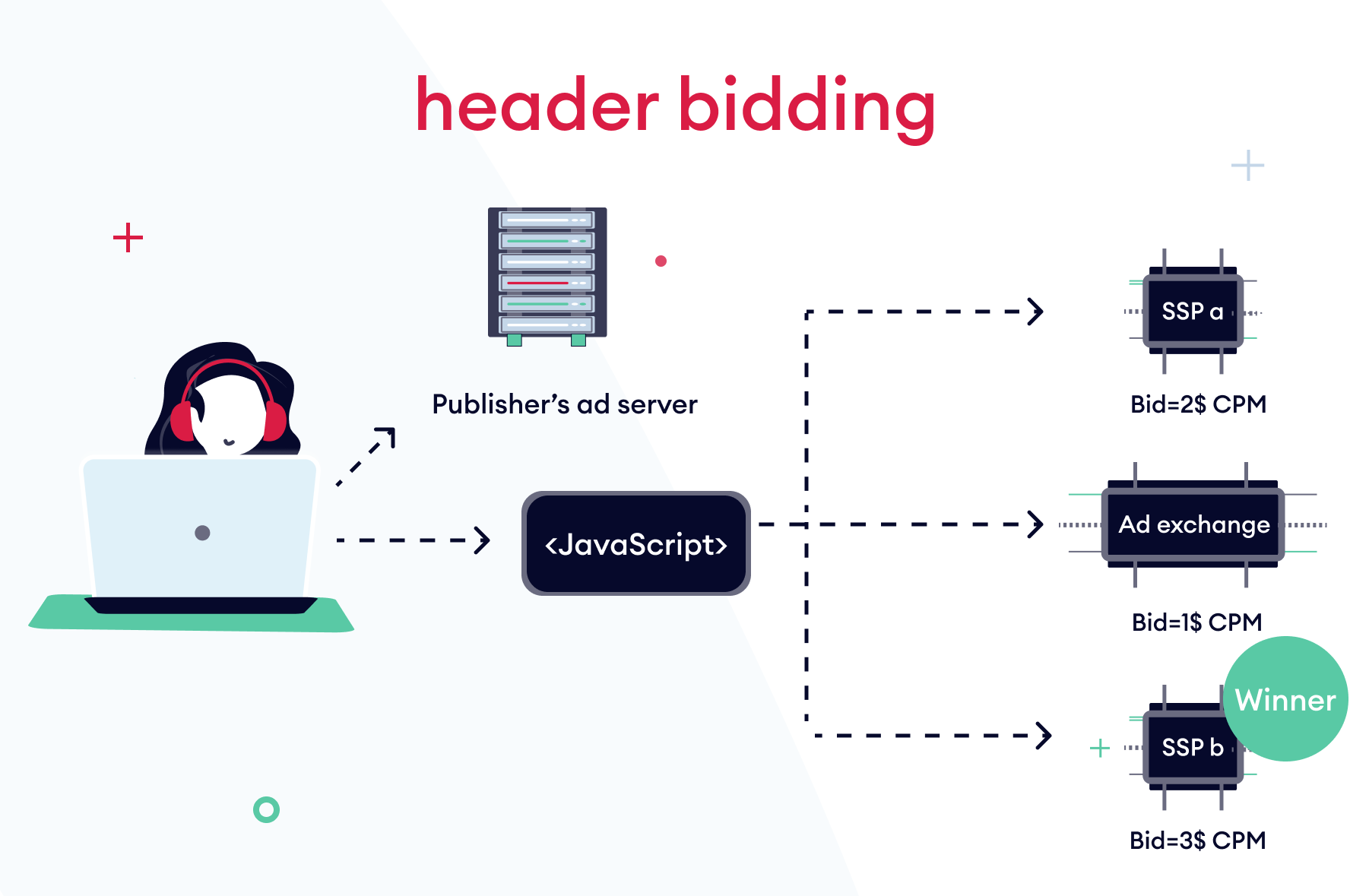
Crafting engaging content that captivates audiences requires time, effort, and expertise – and while profit is a key reward, it also fuels further growth and innovation. Displaying advertisements is one of the most commonly chosen methods to generate revenue from digital activities. When integrating ads into their websites or apps, publishers aim to select the optimal monetization support. But how do you choose among many programmatic ad platforms the one that will best support your success? We have the answer!

What is a programmatic advertising platform?
Before delving into the intricacies of programmatic advertising platforms, it’s good to understand what programmatic advertising is. Programmatic advertising helps advertisers and publishers with automated buying and selling of ad space using real-time bidding (RTB). RTB lies at the heart of programmatic technology because it allows for automated, real-time auctions where ad inventory is bought and sold.
Programmatic advertising platforms use this technology to reduce the manual workload and enable the process that, for advertisers, results in ads being displayed to often targeted users and, for publishers, generating ad revenue. In other words, by hosting targeted ads on your site, you assist advertisers in reaching their audience while earning a portion of the ad spend in return. Long story short, programmatic ads platforms were created to make the process easier for you! This is because, in traditional advertising, deals are often negotiated manually between the advertiser and the publisher, which can be time-consuming and less flexible. Programmatic platforms, on the other hand, automate the buying and selling of ad space in real time, making it much faster and more efficient.
Publishers should also be familiar with header bidding, an advanced programmatic solution that takes ad selling to the next level. In header bidding, a publisher offers the same ad space to multiple demand sources at once, such as ad exchanges and SSPs. This allows real-time auctions to happen simultaneously across all these sources, rather than one at a time. This makes the competition fiercer, which typically drives up ad revenue. However, there are several key considerations that publishers should be aware of. The process can potentially slow down page load speeds if not implemented thoughtfully. Furthermore, header bidding necessitates a sophisticated technical setup and ongoing monitoring to operate effectively. Here, you can take a look at how header bidding fits into the bigger picture (we will explain more about ad exchanges and SSPs in the following paragraph):

What is programmatic advertising software?
Programmatic advertising software makes it possible to sell, buy, and place digital ads on a website or in a mobile app in an automated way. It uses real-time algorithms to target the right audience, enhancing efficiency and removing the need for manual negotiations. Below, you can find the primary types of programmatic advertising software that together constitute a programmatic advertising ecosystem:
- Demand Side Platforms – DSPs – are technological platforms that help advertisers manage ad inventory buying. With their help, they can run targeted ad campaigns;
- Supply Side Platforms – SSPs – allow publishers to manage, sell, and optimize their ad inventory. In the programmatic advertising setup, SSPs and DSPs stand at opposite ends of the spectrum – representing, as the names suggest, either the ad supply or demand side. Supply Side Platforms work by connecting with DSPs, ad exchanges, and ad networks to facilitate seamless transactions on behalf of publishers;
- Data Management Platforms – DMPs – their task is to gather and store data from various sources like websites and mobile apps. This kind of software is used by both supply and demand side;
- Ad exchanges’ main aim is to enable the real-time buying and selling of ad inventory with the help of real-time bidding (RTB). Notably, ad exchanges create a unified virtual marketplace where advertisers connect through a Demand-Side Platform (DSP) to publishers via a Supply-Side Platform (SSP);
- Ad networks act as middlemen, connecting publishers with ad spaces and advertisers who want to display their ads to Internet users. They aggregate ad spaces from various websites or apps and make them available for purchase to interested advertisers.
How programmatic advertising works
The programmatic ad ecosystem offers various auction types (deals) to cater to advertisers’ and publishers’ distinct needs and strategies. They can be carried out through private or open marketplaces on pre-established or more unrestricted terms. These different auctions shape how ad inventory is sold, affecting its availability, transparency, and other aspects. Here are the most typical types of programmatic deals:
- Open auction, as the name suggests, is the type of auction where all eligible buyers can participate. It starts after setting a minimal price, and the highest bid wins;
- Private auction acts similarly to the open one in that a minimal price is set, and the bidder who offers the highest price wins. The difference is that publishers invite a limited number of advertisers to that kind of auction;
- Programmatic Direct is the type of programmatic deal between an advertiser and a publisher. It has two main subtypes:
- Preferred deals operate on a non-guaranteed agreement. The advertiser has priority access to the inventory but isn’t obligated to buy. If they don’t, the inventory goes to the open market,
- Programmatic guaranteed happens when the publisher reserves ad inventory exclusively for a specific advertiser based on detailed, negotiated terms.
To show what a common programmatic advertising process looks like, let’s take a look at what is happening step by step when the user visits the publisher’s website that utilizes an open type of auction:
1. The programmatic process that leads to displaying an ad starts right after a user visits a website or mobile app;
2. The website or app contacts a Supply Side Platform (SSP) with an ad request, signifying the need for an ad display;
3. The programmatic auction that happens in real-time starts, and many advertisers can compete at the same time to “fight” for ad placements on the publisher’s website or app;
4. To improve targeting (which ensures ads are shown to the right audience) and help advertisers reach more users, user data (like location and online habits) is analyzed. Through a Demand Side Platform (DSP), advertisers can specify their ad-buying criteria;
5. The DSP checks the details shared by the SSP about the user to determine the value of an ad impression and submits an offer to the SSP. Ad exchanges control the exchange of information. Then, the auction is conducted thanks to real-time bidding, and the highest bidder gets their ad shown to the user.
Why choose programmatic?
Although programmatic advertising provides value to both the selling and buying sides of the process, here, we will focus on the benefits programmatic advertising has for publishers. By automating the ad-selling process, programmatic saves publishers time and eliminates the need for hands-on effort. Moreover, it enhances ad fill rates by ensuring that available ad spaces are filled with highly relevant ads. This improved performance is mainly due to the system’s connection to multiple Supply-Side Platforms (SSPs), which increases the likelihood of matching the right advertiser with the available inventory. As a result, publishers experience higher revenue and less struggle.

What platform qualities to look for in 2025?
There are many programmatic platforms for publishers to choose from. Before making the final decision, it’s good to verify whether they provide these features:
- They can help you generate great ad revenue. Simply speaking, a company should know the ropes and be experts in yield optimization, which is all about boosting publishers’ ad revenue from ad monetization thanks to the optimization of ad space;
- Another feature to look for in ad monetization partners is whether they comply with digital ad standards and other guidelines and laws, like the General Data Protection Regulation (GDPR). When it comes to data protection, you can also check if they can provide a publisher with a Consent Management Platform (CMP) which is often a mandatory tool that helps to collect and manage personal information and users’ consent;
- The best programmatic ad platforms care about User Experience. They don’t overcrowd your website or app with ads, as sometimes less is more – especially regarding ad density. Often, users may feel discouraged when they can’t properly view the content they came for and leave – a situation every publisher would like to avoid. However, there are more aspects to UX than just proper ad placement – among other things, good ad platform technology shouldn’t have a bad influence on Google Core Web Vitals, which are metrics that indicate web page experience and also are essential for SEO;
- Check whether the platform you are about to choose has good customer service. Publishers can indeed solve many problems with ad monetization. However, there can be some challenges that will need the assistance of specialists. Sometimes, it’s also valuable when the company offers customer service in your native language;
- Verify whether a programmatic ad platform offers services that align with your needs. For example, if you are an app developer who wishes to monetize a mobile game, you have to make sure that the chosen company can meet your needs.
Is Google Ads a programmatic platform?
The short answer to the question, “Is Google Ads a programmatic platform?” is yes! It’s a place where advertisers can set up and manage programmatic advertising campaigns. Importantly, there’s no fixed spending limit, and advertisers can decide how much to spend on digital advertising campaigns. However, since this article is primarily intended for publishers, we will concentrate on programmatic ad platforms that cater to their needs.
Best programmatic advertising platforms
Here, you can find the selection of platforms that offer great programmatic advertising solutions to digital publishers:
- optAd360 is an ads platform that offers a range of publisher-focused solutions for both apps and website monetization, along with access to a vast network of premium demand partners and ad exchanges, including Google’s AdX. The company is also entrusted by Google under the GCPP program and is a member of the IAB. The main features and benefits of joining the optAd360 network include the following:
- optAd360 AI Engine is a machine-learning technology that acts as a central hub for various company products and automates managing and selling ad inventory. Publishers often see a substantial increase in earnings, with an average rise of 35%, alongside improvements in all three Core Web Vitals metrics after adopting this technology;
- Revenue Booster is a feature that allows publishers to boost their earnings by optimizing existing ad layouts – introducing new ad formats in sections of their websites with higher user engagement;
- Ad Mapper, on the other hand, builds ad layouts from the ground up. The technology takes into account user engagement, audience demographics, and specific website characteristics to find the best place for many ad formats, types, and sizes;
- Recovery Tool is an ally of publishers when ad units can’t be loaded. It aids in monetizing ad impressions by re-selling and filling ad places that, for instance, failed to load due to website connection timeout or ad server failure during page loading;
- optAd360 CMP (Consent Management Platform) helps publishers manage user consent for collecting and using personal data. It’s especially vital for those who monetize with ads, as it allows for more personalized ads;
- Possibility of benefiting from the Multiple Customer Management (MCM) feature, thanks to the Manage Inventory option. Simply put, it allows publishers to outsource the management of their full or partial ad inventory, all while gaining access to Google Ad Exchange and Programmatic Direct deals for added revenue;
- optAd360 offers various ad formats for both web and mobile environments, chosen specifically to best suit the publisher’s content. Among them, you will find classic formats but also more intriguing ones, like video, Floating, Native, Interstitial, and Sticky ads;
- optAd360 provides customer support in 17 languages: Arabic, English, Filipino, French, German, Indonesian, Italian, Japanese, Korean, Polish, Portuguese, Russian, Spanish, Thai, Turkish, Ukrainian, and Vietnamese;
- Publishers can benefit from the company website in 8 languages: English, Spanish, Indonesian, Korean, Polish, Portuguese, Thai and Vietnamese;
- Additionally, you can expect payments within 30 days – much faster than the 60-day industry norm. Multiple payout methods are also available, such as PayPal, Payoneer, or a bank transfer.
To start monetizing your digital content with optAd360, you have to make sure that your website’s or mobile app’s content:
-
- is legal,
- does not violate copyrights,
- does not contain explicit sexual, vulgar, hateful, violent, or terrorist content or promote illegal or harmful activities,
- additionally, it must meet the traffic threshold of 50,000 page views per month for specific countries or 500,000 for all others.
To learn more, we encourage you to get familiar with the requirements to join the optAd360 network;
- AdSense is a digital advertising platform that allows website owners to have a smooth monetization process. It’s usually the first platform they turn to, as it’s free, accessible, and doesn’t require an impression threshold. However, you have to remember that to start monetizing with AdSense, you have to be the website owner, and the content has to be in line with Google Publisher Policies. Additionally, you are eligible to have the assistance of a Google specialist if your website exceeds 300 thousand page views monthly;
- Google Ad Manager (GAM) is a programmatic ads platform dedicated to larger publishers. It allows them to manage web and app inventory. In order to qualify for a Google Ad Manager account, you must first sign up for Google AdSense. One key advantage of GAM is that publishers can access its robust features and tools without any upfront costs, as long as they don’t exceed the monthly impression threshold in a given region: for instance, publishers in the USA, Canada, Australia, and New Zealand qualify for free usage if they generate under 90 million monthly impressions for non-video ads. In other countries, such as Argentina, Germany, and Vietnam, this threshold rises to 200 million. If your usage exceeds these thresholds, you’ll be required to switch to Google Ad Manager 360, the premium version of the platform;
- Google Ad Manager 360 is a paid, premium version of GAM tailored for large-scale digital content creators who wish more control over their ad inventories or access to premium features like advanced reporting and analytics options. Various elements, such as the number of monthly impressions and extra functionalities chosen, influence the ultimate price for Google Ad Manager 360. To benefit from GAM 360 solutions, there is no need to prove the impression number;
- AdMob is a free-of-charge platform that offers programmatic advertising solutions for mobile app developers. You don’t need to meet any traffic thresholds to join AdMob, but if your app reaches 100,000 downloads, you may get a free session with a Google expert to help you navigate the platform. Signing up for AdMob requires being 18+, having a Google account, a mobile app to monetize, and occasionally a phone number. After confirming your identity and payment info, your app must be verified to meet Google’s guidelines. AdMob offers a variety of app ad formats, including Banner, Interstitial, Rewarded, Native, and App Open Ads.
Comparison of major platforms
AdSense vs optAd360
AdSense is an easy-to-use, free platform that allows website owners to quickly monetize their content with minimal setup, making it ideal for beginners and small publishers. optAd360, on the other hand, offers advanced AI-driven tools, multiple ad formats, and access to premium demand partners, often increasing publisher revenue by an average of 35%.
GAM vs AdSense
Google Ad Manager (GAM) is designed for larger publishers who need to manage multiple ad inventories and programmatic deals, offering robust tools without upfront costs if usage stays below regional thresholds. AdSense is simpler and more accessible, with lower requirements and a focus on quick monetization for small to medium-sized websites.
GAM vs GAM 360
GAM 360 is the premium version of Google Ad Manager, offering advanced reporting, analytics, and greater control over ad inventory compared to the free GAM platform. While standard GAM has usage thresholds and limited features for free users, GAM 360 removes these restrictions and provides access to more sophisticated tools for large-scale publishers. Essentially, GAM serves as an entry-level programmatic solution, whereas GAM 360 targets publishers who require enterprise-level capabilities and premium support.
Maximize your ad earnings with zero tech hassle
Since programmatic is such a vast topic, we’ve provided a programmatic glossary on our blog. But publishers who collaborate with us don’t need to worry about the technical details – that’s what we’re here for! All you need to do is fill out the registration form. Start today and reap the rewards tomorrow!


